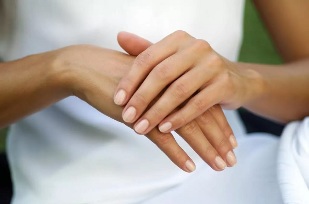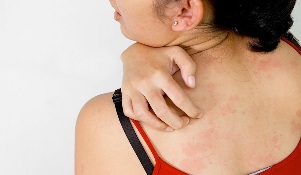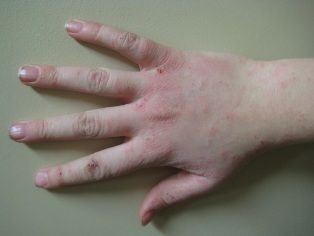
Psoriasis is a relatively common dermatological disease, characterized by severe irritation and itching of the affected skin. There are many types of this disease. The most common types of psoriasis should be considered in detail, and these lesions can also be seen in photos.
Causes of disease
The disease is usually chronic. It grows for the following reasons:
- Weakens the immune system. Abnormal immune processes cause thickening of the skin, as a result of which chronic forms of the disease gradually begin to develop.
- Genetic predisposition. The chances of damage to the skin are quite high if at least one of the parents suffers from psoriasis.
- Nervous disorders and emotional turmoil. This is one of the most serious factors in the development of this skin disease.
- Hormonal imbalance. Pathological changes in the endocrine system give the initial impetus to the appearance of the first signs of psoriasis.
- Disorders of metabolic processes in the body. This is due to a lack of vitamins and other nutrients.
- Presence of parasitic diseases. Toxic substances that various types of helminths are poisoned by the human body can cause damage to the skin.
Modern medicine has not yet discovered the true cause of this pathology. Often, experts find a link between immune system disorders and psoriatic eruption.
Often, experts find a link between immune system disorders and psoriatic eruption.
Symptoms of the disease
As already mentioned, there are many types of this dermatological disease. Depending on this, the patient may have different symptoms. The most common forms of psoriasis and their symptoms should be considered in more detail.
Psoriasis vulgaris
Represents the appearance of a plaque with white scales. Affected skin becomes inflamed and discolored. Such plaques gradually increase in size, the scales peeling off over time. Psoriasis on the hands may not have scaly formations, especially on the folds. In these places, the skin becomes red, itching and severe burning appear. Inguinal psoriasis develops in a similar way. Psoriasis vulgaris of the body can affect most areas of the skin.
Tears psoriasis
This form of the disease gets its name because of the form of convex psoriatic eruption in the form of a drop. They have a purpleish red color. Drip-shaped neoplasms usually spread to the back, abdomen, and affect almost every part of the body. They cause severe itching, especially during periods of exacerbation. Often, this form of the disease develops as a result of past infectious diseases.
Often, this form of the disease develops as a result of past infectious diseases.
Pustular psoriasis: photo
This type of psoriasis is the appearance of small growths filled with clear fluid. The skin around this acne becomes inflamed and becomes bright red. He was hit by fragments quickly, causing a painful sensation. Often this form of the disease appears on the nail plate. What pustular psoriasis can look like in a photo.
Arthritis arthropathic
It develops gradually, the early stages of the disease can pass without any symptoms. Articular tissue and damaged muscle. As the patient develops, he begins to feel an unpleasant sensation in the affected joint area, stiffness of movement is observed, especially after waking up. The skin in the affected area becomes inflamed, has a reddish color. The upper and lower joints are most often affected by psoriatic arthrosis.
Palmar-plantar Psoriasis
This is a fairly common form of the disease. It is characterized by damage to the palms and soles of the feet. In these places, the focus is solid with clear edges. Persistent dryness and exfoliation of the skin can cause cracking. In such a situation, be very careful as an infection on the wound that arises may occur.  The skin in the affected area becomes hard and rough.
The skin in the affected area becomes hard and rough.
Early Psoriasis: Photos
How did the development of this pathology begin? The disease at an early stage may not be symptomatic. Usually small pink plaques appear. The surface of the skin on them is still smooth and shiny. After a few days, the plaque is covered with small scales, the itching in the affected area begins to bother. These scales easily move away from the plaque, underneath it the skin looks inflamed. This process is called puncture psoriasis.
Psoriasis in children
This disease can even occur in newborns. Always accompanied by a painful sensation in the affected area, after which there is a severe itching. The plaques formed most often crack, small bleeding begins. This process is called capillary psoriasis. The danger of form lies in the possibility of infection in the wound formed in the child.
Psoriasis on the head: photo
Damage to the scalp is not uncommon with this disease. With such a lesion shape, hair falls out and stops growing. Focus localization can be seen in places like this in the head:
- psoriasis in the back of the ear;
- in the occipital area and on the forehead;
- psoriasis on the neck;
- on the scalp.

Headaches are usually accompanied by the following symptoms:
- slightly scaly with itching and irritation;
- inflammation in the affected area;
- scratching sore spots causes damage;
- skin gradually becomes coarser and thicker;
- dandruff on the scalp;
- skin is particularly vulnerable to severe trauma;
- itching increases daily.
Advanced psoriasis - photo
More advanced forms of the disease can lead to dangerous consequences. In addition to psoriatic arthrosis, one can develop the following pathologies:
- dysfunction of the heart and blood vessels;
- ischemic disease;
- stroke;
- cardiac arrhythmias.

The patient begins to feel such a disease:
- inflamed purple skin;
- general weakness of the body;
- increase in body temperature;
- heart palpitations;
- severe appetite until completely gone;
- muscle and joint weakness.
With advanced forms of the disease, significant areas of skin will be affected. The patient feels constant weakness and fatigue. Therefore, it is very important to start treatment early.
As a result of this disease
It is no secret that psoriatic eruptions significantly damage the quality of daily life. Affected people may have the following psychophysiological problems:
- afraid to play sports;
- the need to always hide your illness;
- Self-confidence is gradually lost;
- development of chronic depression;
- problems with the opposite sex, one begins to avoid intimate relationships with loved ones.
Also, in some cases, this pathology has a negative impact on a person's choice of professional activities.
Thus, the disease has a negative impact not only on physical health, but also on psycho-emotional states. At the first sign of psoriasis, you should contact a specialist for help. He will provide the most effective treatment, helping to get rid of the rash as soon as possible.























